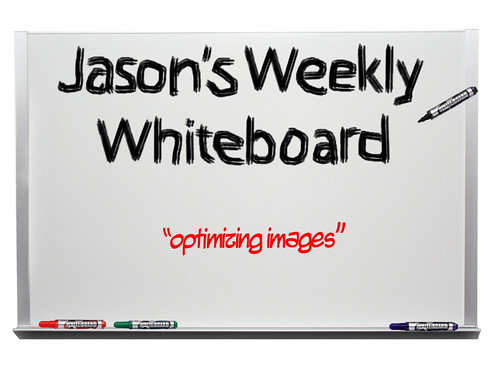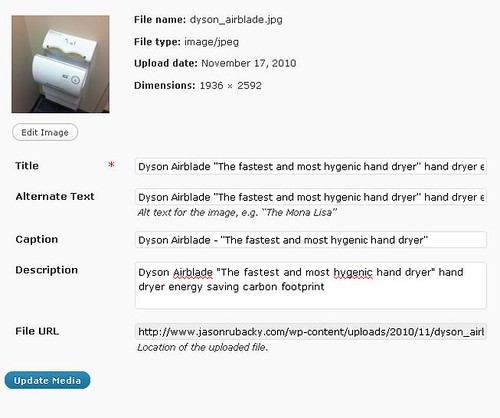Why should you optimize an image?

I would counter that question with… Why wouldn’t you optimize an image? There are absolutely no cons to doing so, unless you consider obtaining additional targeted traffic to your site a con. :)
I am going to use WordPress in my example for today, but you can use these same tags if you are using another blogging platform or a hand coded blog.
Using the image below as a guide, I am going to show you how simple and fast it is to optimize your images and why it is so beneficial.
First and foremost is the “File URL”. This is one of the most important pieces to optimizing an image and currently (from my testing and observations) one of the only ways “majority” of people are optimizing at this time. The funny part about it is, they don’t even know that they are optimizing their images and ranking in the top 3 spots without any effort. Just by having the product name in their “File URL” is giving them amazing image placement.
The key to a good “File URL” is just to use natural keywords to describe your image.
Example: Dyson_Airblade.jpg
Feel free to extend on that, but keeping the “File URL” clean and simple is a good idea. And as far as using hyphens to underscores, I have found underscores for product images to work better… but it’s always a great idea to test.. test and keep testing! *Stay on top of the game*
The rest is just icing on the cake! When I say rest I mean the “Title”, “Alt Text” “Caption” and “Description”. I use the “exact match” strategy when it comes to my “Title” “Alt Text” and “Description”. Basically what you want to do here is to think of every possible keyword to describe the image and include them into all of the above, exactly the same. This will help the SERP’s find your images easier and faster and get you in the #1-3 spots in a image search in no time!
Last but not least is the “Caption”. You do not have to use this field, but what it does is add a caption below the optimized photo that you are posting. In turn adding some additional content to your post. I typically make the caption short and sweet and obviously lean on the keyword I am trying to rank for.
And that is how you can easily rank your images and increase your traffic in a very short period of time.
*Note be sure to use some good analytics that have the capability to show you where exactly the traffic is coming from including image searches and what image you “visitor” was looking for.


 Robert Harvey says
Robert Harvey says
November 19, 2010 at 4:30 amNice post. Though one useful tip you’ve missed is before uploading it to wordpress. Optimizing your image to be the right size. Faster page load times are a new google factor to consider, while faster page load times also yield longer visitor times. So I’d tend to make sure my image is as high quality but as small as possible. There are a number of tools like jpegclub.org and OptiPNG [sourceforge] but the easiest and best all round one online has to be http://www.smushit.com/ysmush.it/. Of course if you’re really serious you’ll be doing this already in the image editing software you use.
 refurbished computers cheap says
refurbished computers cheap says
November 29, 2010 at 6:07 amI would like to appreciate the work of blog author that the person provided us with an extremely excellent information regarding the topic. I really learned something from this blog and started to contribute my ideas via commenting on this blog. Keep it up!
 Penny says
Penny says
December 2, 2010 at 11:00 amI usually change the file url to be the page url which is usually my website/keyword. I wonder if this accomplishes the same thing, or if it makes the image harder to index. I recommend adding an image to every page. After I did this with one site, I jumped up in the rankings almost right away.
 refurbished computer says
refurbished computer says
January 6, 2011 at 12:22 amAfter reading this blog I feel that I have gain a lot of good information regarding the topic which will definitely help me in future. Blogs like these should be really kept updated such as this blog.I personally thank to this blogger for doing such a great work.
 Jeremy says
Jeremy says
January 17, 2011 at 2:40 amWOW! Great info. Looks like I have some testing to do.
 Home'se Curity says
Home'se Curity says
January 21, 2011 at 9:01 pmI know that a lot of the images that I had running on my datafeed sites resulted in almost 15% of my SaS sales.
Great writeup!
 Aaron says
Aaron says
February 11, 2011 at 6:43 pmGreat post Jason, thanks for sharing these tips on optimizing images. I need to get to work updating my file names!
 Krista says
Krista says
April 27, 2011 at 5:27 pmGreat article, Jason! Thanks for making it so clear and easy to understand. You did a great job on your webinar today too (4/27/2011). I took copious notes and am already putting things into practice. :-)
 notBofu says
notBofu says
May 11, 2011 at 9:05 pmLol at Bofu… they removed the URL of all other SEO comments but they messed up your Anchor.. so much for comment diversity lol
 Custom Logo Design says
Custom Logo Design says
July 20, 2011 at 8:01 amExcellent article and have taken all you have said onboard. I especially like the Twitter Feed reference and have chosen to go ahead with that one.
 Julie says
Julie says
August 8, 2011 at 8:04 amWhat I learned from your post is that the image seo can be more than just two or three words. I always kept the title, caption and alt text very short. Now I will take advantage of all the keywords I can use.
 Image resize says
Image resize says
August 19, 2015 at 4:37 amI never go under 80% quality when i export my pictures.
But thank you for the tips about gif, i tried it and it works good.
I am very happy that I have found this during my search.
Thanks for sharing with us.
 Bhawani Rajpurohit says
Bhawani Rajpurohit says
December 22, 2015 at 2:51 amThis is awesome.These are all great tips for someone with a bit higher skill level.
For more information: http://www.labstech.org/optimizing-images-website-2014-05-20/